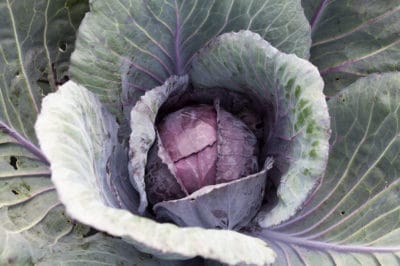The Red Growing Zone
Red cabbage likes the same growing conditions that green cabbage likes.
- Choose a spot with rich, loamy or sandy soil that has a pH of 6.5 to 6.8. Before planting your cabbage, work a 2-inch thick layer of compost 3 inches to 4 inches down into the soil
- Keep in mind that all cabbages prefer full to partial sun.
- The soil should retain moisture at a depth of two inches or more, but the surface should be well-drained. Avoid spots where standing water collects and ones that remain muddy for days after a rain.
- You should also avoid the spaces where you planted cabbage and closely related plants like collards, kale, Brussels sprouts, and cauliflower during the previous growing season.
Planting Your Garden Red
Red cabbage grows from seeds or seedlings.
Starting Your Own Seedlings
If you want to start your own seedlings for spring planting, sow the seeds six to eight weeks before the last frost date in your area. Space them 2 inches apart and cover them with 1/4 inch of soil. Keep the seeds in a cool, well-lit spot or under a grow light or a cool white fluorescent light.
If you plant the seeds in toilet paper rolls that you have cut to lengths of 2 inches to 3 inches, you can transplant the cabbages in the tube and have a ready-made collar to protect the cabbage from cutworms.
You should transplant your seedlings two to three weeks before the last frost date in your area.
Begin preparing your seedlings for transplanting a week or two before you begin to transplant them. Move them outdoors to a sheltered area and leave them for two hours for the first day. On the second day, leave them out for four hours, making sure that they receive one hour of morning sun. Keep extending the amount of time that you leave your seedlings outdoors and the number of hours that they spend in the morning sun. Eventually, you can begin leaving your seedlings outdoors all night, as long as you aren’t expecting a frost.
When you transplant your seedlings, space them 6 inches to 12 inches apart in rows that are 1 foot to 2 feet apart. Dig a hole deep enough to hold the seedling and its roots. If you have grown them in toilet paper tubes, leave about half of the tube above ground. Otherwise, leave 1 inch to 2 inches of the stem above ground.
Sowing Your Seeds Directly in the Garden
If you prefer to sow your cabbage seeds directly in the garden, wait until two weeks before the last frost date in your area. For an early spring planting, space them 2 inches apart in rows that are 1 foot to 2 feet apart and cover them with 1/2 inch of soil. For later plantings, space the seeds 6 inches apart.
Red, Red Rain – Watering Your Cabbage
Cabbage needs to be watered on a steady, even basis to prevent growth spurts that can split the heads. It should receive 2 inches of water a week, and it’s best to water it using a soaker hose to keep the leaves from getting wet, especially when the humidity is high. Wet leaves can suffer from black rot.
Mulch placed around your cabbages will help the soil retain moisture.
Feeding Cabbage
Cabbage feeds heavily from the nutrients in the soil, so it will need an application of rich compost three weeks after you plant it. You should then apply compost again every three weeks throughout the growing season.
Going on Pest Patrol
Red cabbage suffers from the same pests and diseases as green cabbage. Pests include:
- Imported cabbage worms
- Harlequin bugs
- Cutworms
- Cabbage loopers
- Aphids
The potential diseases are:
- Black leg
- Black rot
- Club root
- Fusarium wilt
You can protect your red cabbage from pests by installing row covers as soon as you plant it; by picking off the insects, eggs, and worms as soon as you spot them; by planting companion plants such as marigolds, tansy, and thyme that either repel the pests or lure them from your cabbage; and by using organic sprays.
If a cabbage becomes diseased, the best course of action is to pull it up and discard it. Don’t add it to your compost. Crop rotation is the best way to prevent recurring problems with either diseases or pests.
Reaping Your Red Cabbage Reward
Your red cabbage is ready for harvesting when the head feels firm when you squeeze it. Simply use a sharp knife to cut the cabbage from the stem close to the base of the cabbage.
